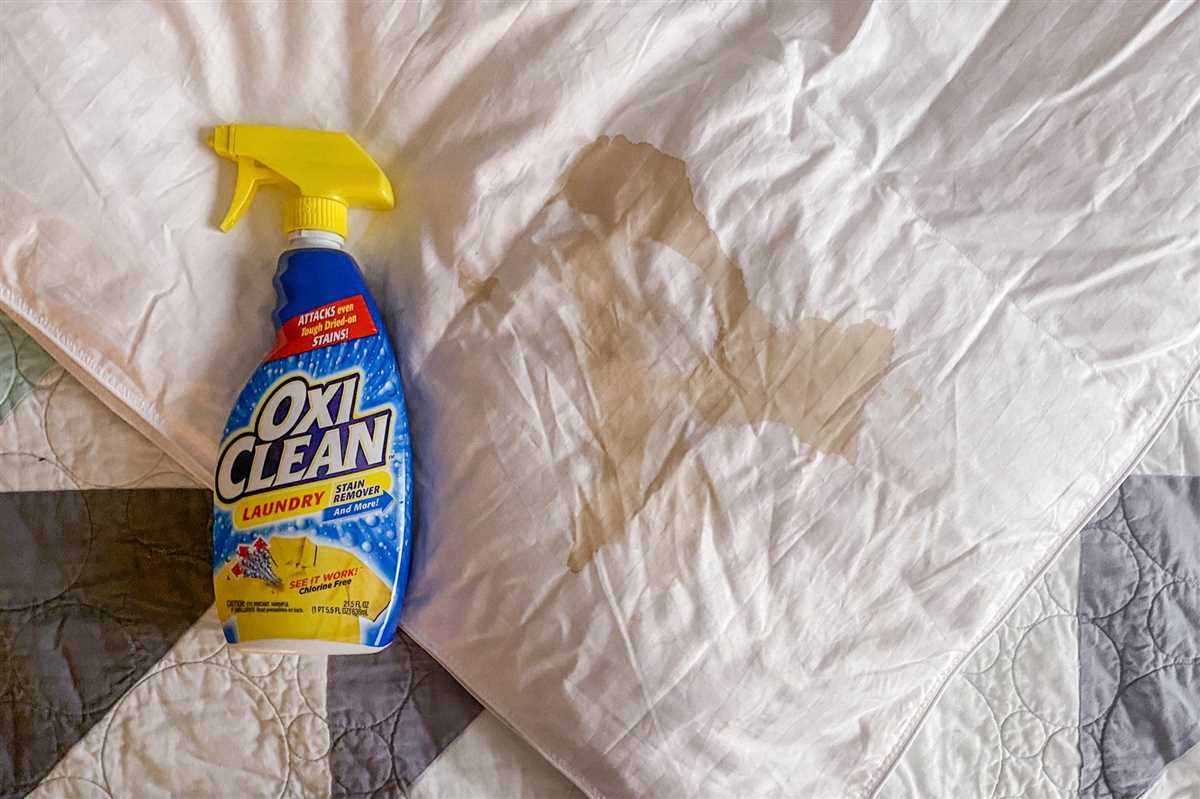




If you have a comforter, you know how important it is to keep it clean and fresh. However, washing a comforter can be a bit tricky, especially if you have a large or delicate one. In this step-by-step guide, we will walk you through the process of washing a comforter to ensure that it comes out clean and smelling great.
Step 1: Check the Label
Before you begin washing your comforter, it is important to check the care label for any specific instructions or recommendations. Some comforters may require special care, such as dry cleaning or spot cleaning only. Make sure to follow the instructions on the label to avoid damaging your comforter.
Step 2: Pre-Treat Stains
If your comforter has any stains, it is a good idea to pre-treat them before washing. You can use a stain remover or a mixture of laundry detergent and water to spot clean the stained areas. Gently rub the solution into the stains and let it sit for a few minutes before washing.
Step 3: Choose the Right Washing Machine
Depending on the size of your comforter, you may need to use a large-capacity washing machine. It is important to choose the right machine to ensure that your comforter has enough room to move around during the wash cycle. If you don’t have a large-capacity machine, consider taking your comforter to a laundromat with oversized machines.
Step 4: Use the Right Detergent
When washing your comforter, make sure to use a mild detergent that is suitable for the fabric. Avoid using bleach or harsh chemicals, as they can damage the comforter’s fill and outer fabric. Follow the detergent manufacturer’s instructions for the appropriate amount to use based on the size of your comforter.
Step 5: Load and Wash
Place your comforter in the washing machine, making sure it is evenly distributed. Add the detergent and set the machine to a gentle or delicate cycle with cold water. Avoid using hot water, as it can shrink or damage the comforter. Let the machine run its cycle and make sure to give it enough time to thoroughly clean the comforter.
Tip: Adding a few tennis balls or dryer balls to the dryer can help fluff up the comforter and prevent it from clumping together.
Step 6: Dry Properly
After the wash cycle is complete, it is important to dry your comforter properly. Depending on the fabric and size of your comforter, you can choose to air dry it or use a dryer. If you decide to use a dryer, set it to a low heat or air-dry setting to avoid overheating or shrinking the comforter. Make sure to check the comforter regularly and avoid over-drying it.
By following these steps, you can wash your comforter with ease and ensure that it stays clean and fresh for a long time. Remember to regularly inspect and clean your comforter to maintain its quality and extend its lifespan.
Step 1: Preparing Your Comforter
Before you begin washing your comforter, it’s important to properly prepare it. This will ensure that the washing process is as effective as possible and help maintain the quality of your comforter.
1. Check the care label
The first step in preparing your comforter for washing is to check the care label. Follow the instructions provided on the label to determine the appropriate washing method for your comforter. Some comforters may be machine washable, while others may require professional cleaning.
2. Spot treat any stains

If your comforter has any noticeable stains, it’s a good idea to spot treat them before washing. This will help remove the stains more effectively during the wash. Use a stain remover or a mixture of gentle detergent and water to treat the stains. Gently rub the solution into the stained areas using a clean cloth or sponge.
3. Empty your washing machine

Before placing your comforter in the washing machine, make sure it’s empty. Remove any other items, such as clothes or towels, that may be inside. This will prevent the comforter from getting tangled or damaged during the wash.
4. Check for loose threads or tears
Inspect your comforter for any loose threads or tears. These can potentially worsen during the washing process. If you notice any loose threads, carefully trim them to prevent further damage. If there are any tears, consider repairing them before washing to avoid further tearing.
5. Shake or fluff the comforter
To ensure an even wash, shake or fluff your comforter before placing it in the washing machine. This will help distribute the detergent and water more evenly, resulting in a thorough clean. Gently shake the comforter outside or use your hands to fluff it up.
By properly preparing your comforter before washing, you’ll set the stage for a successful and effective cleaning process. This will help maintain the quality of your comforter and ensure it remains fresh and comfortable.
Remove any pillowcases or shams
Before washing your comforter, it is important to remove any pillowcases or shams that may be on it. These items should be washed separately according to their care instructions. Removing them before washing the comforter will help prevent tangling and ensure a more thorough and effective cleaning.
To remove the pillowcases or shams, simply unzip or unbutton them from the comforter. If they are attached with a zipper, carefully slide the zipper pull down to open it. If they are attached with buttons, unfasten all the buttons to separate them from the comforter.
Once the pillowcases or shams have been removed, set them aside to be washed later. The comforter can now be properly cleaned without any hindrances.
It is worth noting that if the comforter has any decorative covers or duvet covers, these should also be removed before washing. Similar to the pillowcases or shams, these covers may have their own care instructions that should be followed for proper cleaning.
Check for any stains or damage
Before washing your comforter, it’s important to check for any stains or damage that may require special attention. This step will help ensure that your comforter is properly cleaned and maintained.
Inspect for stains
Begin by inspecting the comforter for any noticeable stains or spots. Pay close attention to areas that are more likely to get stained, such as food or beverage spills, sweat stains, or pet stains.
If you come across any stains, it’s best to pretreat them before washing. This will help loosen and remove the stains more effectively. You can use a stain remover or a mixture of detergent and water to pretreat the stains.
Check for damage
In addition to stains, check the comforter for any signs of damage. Look for tears, loose threading, or any other potential issues that may need to be fixed before washing.
If you notice any damage, it’s advisable to repair it before proceeding with washing. This will prevent further damage and ensure the longevity of your comforter.
Take note of care instructions
Lastly, refer to the care instructions provided by the manufacturer. Some comforters may have specific washing guidelines or require special care. Follow the instructions to prevent any damage and to keep your comforter in good condition.
By thoroughly checking your comforter for stains and damage, you can take the necessary steps to address them before washing. This will help ensure that your comforter is thoroughly cleaned and maintained, extending its lifespan and keeping it fresh and comfortable for years to come.
Step 2: Choosing the Right Washing Machine
When it comes to washing a comforter, it’s important to choose the right washing machine to ensure a thorough and effective clean. Here are some factors to consider in selecting the right washing machine:
1. Capacity:
Check the capacity of your washing machine to ensure it can accommodate the size of your comforter. Comforters are generally bulky and may require a larger machine with a bigger drum capacity.
2. Cycle Options:
Look for a washing machine with a delicate or gentle cycle option. Comforters are often made of delicate materials and require a gentle wash. Having a dedicated cycle for delicate items ensures that your comforter receives the appropriate care during washing.
3. Agitation:
Consider whether you want a top-loading or front-loading washing machine. Top-loading machines tend to have an agitator in the center of the drum, which may cause tangling and potential damage to your comforter. Front-loading machines usually have a gentler washing action, making them more suitable for washing comforters.
4. Water Temperature Control:
Make sure the washing machine offers temperature control options. Most comforters require a cold or lukewarm wash to prevent shrinking or damage to the fabric. Being able to adjust the water temperature ensures that you can wash your comforter at the appropriate temperature.
5. Extra Features:
Consider any additional features that may be beneficial for washing your comforter. Some washing machines offer an extra rinse cycle, which can help to remove any remaining detergent residue. Others may have a pre-soak function, which can be useful for treating stains or heavily soiled areas on your comforter.
By taking these factors into account, you can select the right washing machine that will provide the necessary care and effective cleaning for your comforter. Choosing the right machine will help ensure that your comforter comes out fresh, clean, and ready to provide you with a good night’s sleep.
Make sure your machine can accommodate your comforter
Before you start washing your comforter, you need to make sure that your washing machine can accommodate its size and weight. Comforters are generally bulkier and heavier than regular laundry, so not all machines may be suitable for washing them.
Check the capacity of your washing machine to see if it can handle the size of your comforter. The capacity is usually measured in pounds or kilograms, and it indicates the maximum weight of laundry the machine can hold. If your comforter exceeds the weight capacity, it may not get cleaned properly or could damage your washing machine.
If your comforter is too large for your machine, consider taking it to a laundromat or dry cleaner that has industrial-sized machines. These machines are designed to handle larger items like comforters and can ensure a thorough and effective cleaning.
Additionally, check the washing machine’s instructions to see if there are any specific guidelines for washing bulky items like comforters. Some machines may have special settings or recommendations for cleaning larger items.
Select the appropriate water temperature
When washing a comforter, it’s important to choose the right water temperature to ensure a thorough and effective cleaning. The water temperature you select will depend on the material of your comforter and any specific care instructions provided by the manufacturer. Here are some general guidelines to help you decide:
Hot water

- Hot water is ideal for washing comforters made from synthetic materials or heavily soiled comforters.
- It helps to kill germs, dust mites, and allergens that may be present in your comforter.
- However, using hot water may cause some types of comforters, such as those made from delicate fabrics or filled with down, to lose their shape or become damaged.
Warm water
- Warm water is a good option for comforters made from natural materials, such as cotton, as well as for moderately soiled comforters.
- It provides effective cleaning without the risk of damaging the fabric or filling.
Cold water
- Cold water is suitable for comforters made from delicate fabrics or those labeled as “dry clean only.”
- It helps to prevent shrinking, color fading, and damage to the comforter.
- However, cold water may not be as effective in removing tough stains or killing bacteria, so it’s important to pre-treat any stains before washing.
To determine the best water temperature for your comforter, always refer to the care label or any specific instructions provided by the manufacturer. Following these guidelines will help you to keep your comforter clean and in good condition for years to come.
Step 3: Properly Washing Your Comforter
Washing a comforter requires some special care to ensure that it is cleaned thoroughly without any damage. Follow these steps to properly wash your comforter:
- Read the care instructions: Before washing your comforter, check the care instructions to see if there are any specific guidelines or recommendations. Some comforters may require special handling or have specific water temperature or detergent requirements.
- Pre-treat stains: If there are any stains on your comforter, it’s a good idea to pre-treat them before washing. Apply a small amount of stain remover or laundry detergent directly to the stained area and gently rub it in. Let it sit for a few minutes before washing.
- Select a large-capacity washing machine: Comforters are typically bulky and can take up a lot of space in the washing machine. Make sure you choose a machine that can accommodate the size of your comforter without overcrowding.
- Use a gentle detergent: To avoid damaging the fabric, use a mild, gentle detergent. Avoid using harsh chemicals or bleach that could cause discoloration or weaken the fabric.
- Set the right water temperature: Check the care instructions to determine the appropriate water temperature for washing your comforter. In general, warm water is suitable for most comforters, but some may require cold water.
- Load the comforter into the machine: Place the comforter in the washing machine and make sure it is evenly distributed. Avoid overloading the machine as this can prevent the comforter from getting properly cleaned.
- Select the appropriate wash cycle: Choose a delicate or gentle cycle on your washing machine to ensure a thorough but gentle cleaning of the comforter. Avoid using high-speed or heavy-duty cycles, as they can be too harsh on the fabric.
- Extra rinse: Adding an extra rinse cycle can help remove any remaining detergent or residue from the comforter, leaving it fresh and clean.
- Drying your comforter: After the washing cycle is complete, carefully remove the comforter from the machine. It’s best to air dry the comforter to prevent any shrinking or damage. If you choose to use a dryer, set it to a low heat setting and add a few dryer balls or clean tennis balls to help fluff the comforter and prevent clumping.
Following these steps will help ensure that your comforter is properly cleaned and maintains its quality and durability over time.
FAQ
What is a comforter?
A comforter is a type of bedding that is filled with synthetic or natural materials and is used to provide warmth and comfort while sleeping.
Can I wash a comforter in a regular washing machine?
Yes, you can wash a comforter in a regular washing machine as long as it is large enough to accommodate the size of the comforter. However, it is recommended to use a front-loading machine to avoid damaging the comforter.
How often should I wash my comforter?
It is recommended to wash your comforter every 6 to 12 months. However, if you have allergies or if the comforter gets visibly dirty, you may need to wash it more frequently.
Can I use regular detergent to wash a comforter?
Yes, you can use regular detergent to wash a comforter. However, it is recommended to use a mild detergent and to avoid using bleach or fabric softener, as they can damage the comforter’s material.
What is the best way to dry a comforter?
The best way to dry a comforter is to use a large capacity dryer on a low heat setting. It is important to make sure the comforter is completely dry before storing or using it again to prevent the growth of mold or mildew.
What is a comforter?
A comforter is a thick, quilted blanket filled with down feathers or synthetic materials. It is used to keep you warm while sleeping.
Can you wash a comforter in a regular washing machine?
Yes, you can wash a comforter in a regular washing machine. However, it is important to check the washing instructions on the comforter’s tag to ensure that it is machine washable.













